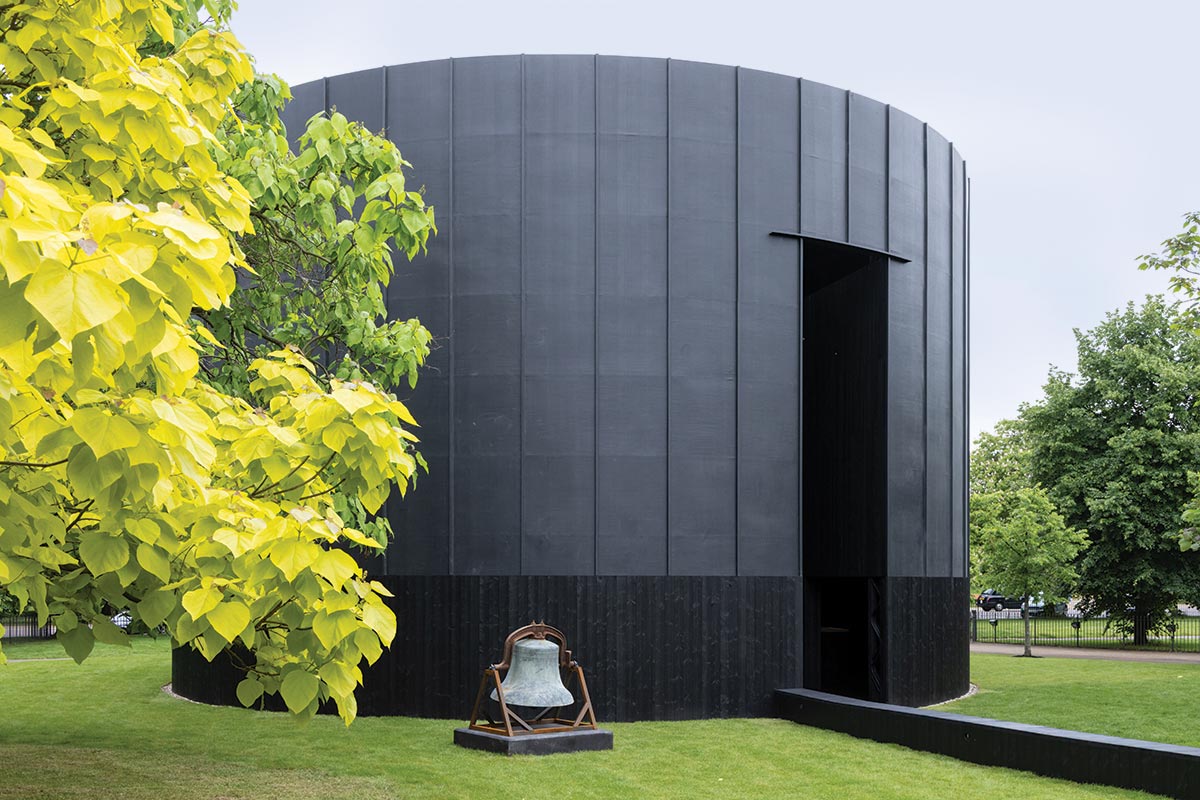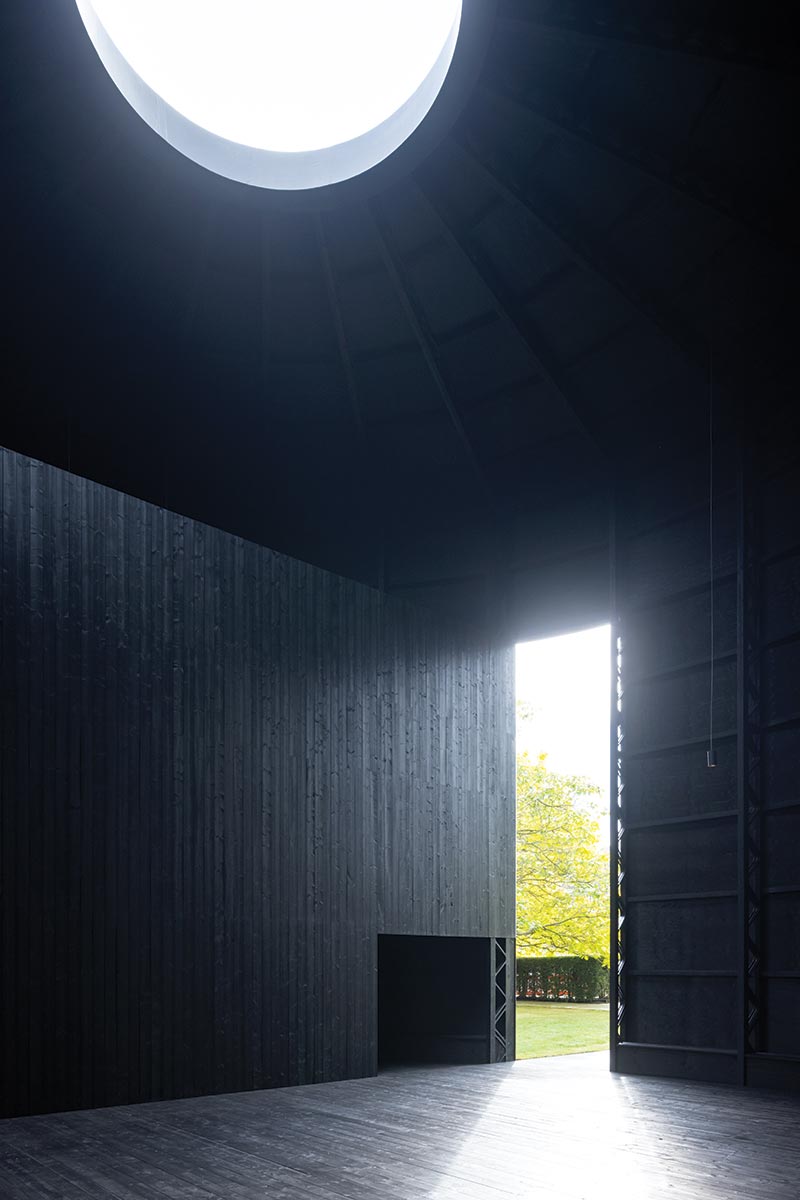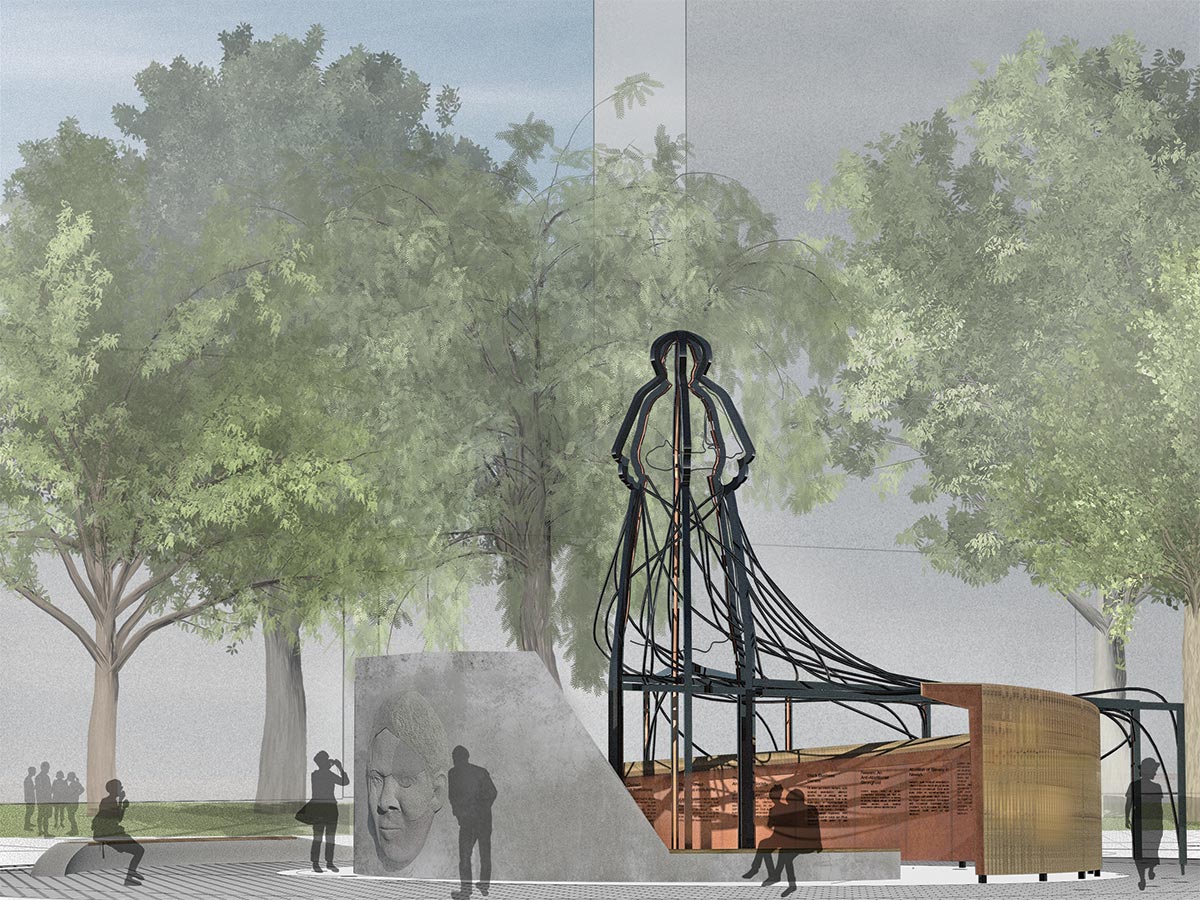View course on architecturalrecord.com »

Photos courtesy of © Iwan Baan
Advisors for Theaster Gates’s Black Chapel focused on country of origin to reduce the risk of forced and child labor.

.
Slavery was abolished in the U.S. in 1865, and is no longer legal anywhere in the world. So it comes as a shock to learn that, worldwide, some 28 million people are currently held in forced labor, including 3.3 mil- lion children, according to estimates from the International Labour Organization. Modern slavery in the construction sector made global headlines last year with the widely reported exploitation of migrant workers during the building of Qatar’s World Cup infrastructure. But what’s less well known—and arguably more open to architects’ influence—is that forced labor taints the extraction, manufacture, and transport of some of the construction sector’s most common materials.
“Risky materials are everywhere,” says Nora Rizzo, ethical materials director at Grace Farms Foundation, a multifaceted humanitarian nonprofit whose recently launched Design for Freedom initiative aims to help eliminate forced labor in building-material supply chains. (A summit to accelerate the movement will be held at Grace Farms, in New Canaan, Connecticut, on March 30.) As a result of supply chains that are rife with forced labor and so disaggregated they’re next to impossible to trace, “there’s likely no building in the world that can claim to be forced-labor free,” Rizzo says. Among the products at greatest risk: brick, copper, glass, minerals, polysilicon (in, for example, solar panels), rubber, steel and iron, stone, textiles, and timber. So-called “precursors”—including soda ash and limestone, that are used in chemical reactions to generate other materials, such as glass and cement—also number among the products most at risk.
Modern slavery can enter supply chains at multiple points in a material’s production. Brick, for example, can be contaminated with forced and child labor during the extraction of its constituent materials and during manufacturing. Debt bondage affects 96 percent of brick-kiln molders in India, one of the world’s top-three brick-producing countries, and encompasses entire families—children included—who have had wages withheld for months at a time. In another example, almost half of the global supply of solar-grade polysilicon comes from quartz mined in China’s Xinjiang Uyghur Autonomous Region, where an estimated 100,000 arbitrarily detained ethnic-minority members, along with impoverished rural workers, may be working in forced-labor conditions. Under the provisions of the U.S.’s recently enacted Uyghur Forced Labor Prevention Act, goods from the region are presumed to be the product of forced labor unless their importer can prove otherwise. Similarly, with timber, up to 50 percent of illegal logging (which accounts for 10 to 30 percent of global timber harvesting, and as much as 90 percent of tropical hard- and softwoods) is dependent on forced labor. Convoluted supply chains make it possible for forced-labor-contaminated timber to be processed with other wood and sold untraceably.
Materials certifications can help. The standards of the Forest Stewardship Council (FSC), for example, require certified wood suppliers to maintain or enhance the social and economic wellbeing of their workers—“which certainly includes avoiding all forced labor,” says Derik Frederiksen, president of FSC US—and to demonstrate conformity with the International Labour Organization’s Core Labour Conventions, which specifically address forced labor. In the U.S., federal laws largely cover these conventions, and certified companies in America are considered low-risk for violations. Even so, they are required to sign a self-assessment, which includes a confirmation that the company eliminates all forms of forced and compulsory labor. In countries such as Brazil, Peru, and Russia, among others, independent auditing organizations “look more closely at the issue of forced labor, as it remains more common,” says Frederiksen. Manufacturers participating in the International Living Future Institute (ILFI)’s Living Products program, as another example, are required to examine their supply chains to identify and mitigate environmental and social risks, including that of forced labor. To meet this Imperative (as the certification requirements are called), manufacturers must perform human rights due diligence on their top 10 suppliers and give preference to those that hold a relevant certification or who have conducted an audit to address risks.
To help design teams prioritize forced-labor-free materials, the Design for Freedom initiative has developed a toolkit. It profiles high-risk materials, highlights relevant certification programs, and outlines steps for making ethical sourcing a project priority. It also defines terminology for communications consistency, offers a questionnaire and cover letter for teams to send to potential suppliers, and provides guidance on incorporating ethical sourcing into specifications. An initial slate of pilot projects that are both informing and implementing the toolkit includes the 2022 Serpentine Pavilion, Black Chapel, in London, by Chicago-based artist Theaster Gates; the Harriet Tubman monument, Shadow of a Face, in Newark, New Jersey, by Studio Cooke John Architecture + Design; and a public library for New Canaan, Connecticut, by Centerbrook Architects & Planners. (The Grace Farms SANAA-designed River Building [RECORD, November 2015] was completed prior to the launch of Design for Freedom. Subsequent efforts and findings from source-tracing the building’s major roof materials were included in a report accompanying the launch.)
Black Chapel [RECORD, July 2022] was a 2,100-square-foot temporary pavilion for gathering and contemplation installed last summer in London’s Kensington Gardens. Its single cylindrical volume was clad in modular timber, stained black and supported on a structure of plywood sheathing, laminated timber ribs, and vertical galvanized-steel trusses, also painted black. Inside the oculus-lit space, seven silvery “tar paintings,” inspired by Gates’s time working with his father, a roofer, “salute the history of labor and the ways in which labor is a beautiful, spiritual way of transmitting energy,” Gates says, in a short film about the project.
To trace the provenance of the project’s few but high forced-labor-risk materials—including plywood and timber, steel, concrete, and weatherproofing membrane—in a tight time frame, Grace Farms, as the project’s responsible-materials advisor, focused on country of origin. Making sure that all materials came from countries where policies and procedures reduce the risk of forced and child labor, and prioritizing suppliers with certifications that reduce the risk even further, provided a baseline level of confidence. Grace Farms and AECOM, the project’s technical advisor, then worked with suppliers and manufacturers to document the materials as far upstream as possible. Supply chains consist of “tiers” defined by their closeness to the purchasing organization or final product. (Tier 1 is the direct supplier of the final product, Tier 2 is the suppliers to them, and so on through as many tiers as it takes to reach the constituent materials’ points of origin.) The Black Chapel team was able to trace many of the project’s components to Tier 4 suppliers, which in some cases encompassed the point of raw-material extraction.
“It was refreshing to find that suppliers were often not surprised by our questions,” says Rizzo. Antislavery legislation, such as the U.K.’s Modern Slavery Act, made much of the information and documentation that the Black Chapel team was requesting available. Even for so simple a building, however, it isn’t yet possible to completely trace every material: “A Design for Freedom project does not get to claim at the end that it is a forced-labor-free building,” says Rizzo. “That’s the ultimate goal, but the market isn’t there.”
For Shadow of a Face, the monument to abolitionist and activist Harriet Tubman (scheduled to open on March 9), suppliers and fabricators were less familiar with the issue of modern slavery in materials’ supply chains. Nina Cooke John, founding principal at Montclair, New Jersey–based Studio Cooke John, engaged with the monument’s builders to raise awareness of the issue and its significance for the project, asking them to prioritize certified materials and, where these weren’t available, to communicate directly with suppliers to understand their practices.
The monument consists of a labyrinthine path defined by curving concrete walls and a steel structure that rises to delineate a silhouette of the figure of Tubman. Integrated into the walls are text, ceramic tiles expressing community members’ own experiences of liberation, snippets of audio narrative, and a bas-relief portrait that offers visitors a touch point to connect with Tubman and her story.

Photos courtesy of Studio Cooke John Architecture + Design
The Supply chain for the steel in Studio Cooke John’s monument to Harriet Tubman was the most transparent of the materials specified.

.
Of the project’s major materials, the supply chain for steel turned out to be the most transparent. As a result of government initiatives to encourage buying American, the metal came with mill certificates attesting to its manufacture in Michigan and in some cases to the sourcing of its raw material within 500 miles—although not all of the raw materials could be traced. For the monument’s wood components, Cooke John originally chose ipé, but source-tracing for the tropical hardwood proved problematic. She substituted black locust from the American Midwest instead, inquiring into its small, noncertified supplier’s practices to confirm that they were both sustainable and ethical. The cement in the project’s concrete came from Pennsylvania, but the source of the cement’s precursors couldn’t be confirmed. Even more difficult to track than these major materials were the myriad components in the monument’s speakers and light fixtures. These were procured from suppliers with internal policies regarding ethical sourcing, but were impossible to fully document. Nonetheless, asking is the first step, says Cooke John: “As designers of a pilot project, we might not get answers immediately, or at all, but the next group of people who ask the questions will find the suppliers more ready to answer them.”
Raising awareness—“a warm-up act for the next round,” as Misha Semënov-Leiva, sustainability coordinator at Centerbrook Architects, calls it—is also a key achievement for the New Canaan Library, a 40,000-square-foot facility now nearing completion. Rehousing an existing library and incorporating such community amenities as an auditorium, teaching kitchen, business support facilities, café, and a park, the design adopts the material language of New Canaan’s pioneering Modernist buildings (which include houses by such prominent midcentury architects as Philip Johnson, Eliot Noyes, and Marcel Breuer) with a palette of glass, Connecticut stone, and regional species of wood. The project’s antislavery priority came late to the design process, after the specifications and construction documents were mostly complete and a number of contracts already awarded. Although the timing was far from ideal in terms of guiding materials choice, the project team resolved to do what it could. They selected 30 of the building’s materials, from across a range of categories, and requested subcontractors to track those materials’ constituents.
While nearly all the suppliers completed the Design for Freedom disclosure form, responses typically revealed nothing beyond practices at U.S.-based Tier 1 facilities. A painstaking series of follow-up exchanges opened the view of the supply chain a little wider each time. One supplier reported that it didn’t have the requested information but asked, “Is this going to be a requirement for doing business with your firm in the future?” That, for Semënov-Leiva was an aha moment: “That said to me that, if enough of us get on board with this and prioritize manufacturers that do disclose, we could actually help shift the building industry.” With a high level of client interest in ethical sourcing, Centerbrook is now updating its standard spec to address the issue, and the Design for Freedom questionnaire forms part of the firm’s vetting of its product library.

Photo courtesy of Studio Cooke John Architecture + Design
Centerbrook ARCHITECTS & PLANNERS used the Design for Freedom toolkit on the New Canaan Library and is now updating its standard spec to address forced labor.
Designing to avoid forced labor in building materials aligns with the need to address the industry’s broken supply chains, stalled productivity, and environmental impacts more broadly, says Chris Sharples, founding principal at SHoP Architects and a member of Design for Freedom’s architecture and construction working group. For the past decade or so, SHoP’s practice has been moving toward industrialized construction processes. This effort encompasses project procurement and delivery—and, as a corollary, the means and methods of construction—more fully than is typical for architects. Information-rich digital prototypes support the adoption of manufacturing-based construction methods, and SHoP’s goal is for the information embedded in its models to include—in addition to such data as dimensional requirements, carbon impacts, and real-time global supply chain risk assessments—information on components’ risk of forced labor. Starting toward that goal, over the last year and a half, the firm has reviewed its most common project typologies, identified their most frequently used materials and assemblies and 117 most frequent suppliers, and is now working with FairSupply, a global ESG (environmental, social, and governance) data provider and consultancy, to estimate the number of people engaged in forced labor per million dollars spent on a material or assembly. “It’s about building a more intimate relationship with our suppliers and materials,” says Sharples. “The way that architects work—our process—has to evolve. And through that process we can change behaviors.”
Advocates for the ethical sourcing of materials point to rapidly increasing transparency around materials’ environmental and health impacts as a hopeful sign for increased transparency around forced labor. “The energy to use our green building ‘muscle memory’ to adopt Design for Freedom is palpable and compounding,” says Sharon Prince, CEO and founder of Grace Farms Foundation. “Only three years after our first public panel at Grace Farms, we are now seeing a rapid uptick broadly across the industry to trace building materials for fair labor.”
An index of human suffering for building materials is now in the early stages of research by an interdisciplinary team from Yale University, University of Michigan, KieranTimberlake, and Buro Happold. Some architecture schools are offering courses and hosting discussions on forced labor. Ultimately, however, eliminating modern slavery from building materials’ supply chains will need the support of policy—within the design professions and at local, national, and international levels. “Architects are a powerful lobby, with a history of helping to create a more equitable world,” says architect and educator Harriet Harriss, also a member of Design for Freedom’s working group. “We’ve been doing it for years, and now we need to do it again.”
Supplemental Materials:
Design for Freedom Overview
Katharine Logan, is an award-winning writer on design, sustainability, and well-being in the built environment. Her work has appeared in Architectural Record (where she is a contributing editor), Landscape Architecture Magazine, BuildingGreen Report, USGBC+, and Planning, among others. She holds a graduate professional degree in architecture.
View course on architecturalrecord.com »

Photos courtesy of © Iwan Baan
Advisors for Theaster Gates’s Black Chapel focused on country of origin to reduce the risk of forced and child labor.

.
Slavery was abolished in the U.S. in 1865, and is no longer legal anywhere in the world. So it comes as a shock to learn that, worldwide, some 28 million people are currently held in forced labor, including 3.3 mil- lion children, according to estimates from the International Labour Organization. Modern slavery in the construction sector made global headlines last year with the widely reported exploitation of migrant workers during the building of Qatar’s World Cup infrastructure. But what’s less well known—and arguably more open to architects’ influence—is that forced labor taints the extraction, manufacture, and transport of some of the construction sector’s most common materials.
“Risky materials are everywhere,” says Nora Rizzo, ethical materials director at Grace Farms Foundation, a multifaceted humanitarian nonprofit whose recently launched Design for Freedom initiative aims to help eliminate forced labor in building-material supply chains. (A summit to accelerate the movement will be held at Grace Farms, in New Canaan, Connecticut, on March 30.) As a result of supply chains that are rife with forced labor and so disaggregated they’re next to impossible to trace, “there’s likely no building in the world that can claim to be forced-labor free,” Rizzo says. Among the products at greatest risk: brick, copper, glass, minerals, polysilicon (in, for example, solar panels), rubber, steel and iron, stone, textiles, and timber. So-called “precursors”—including soda ash and limestone, that are used in chemical reactions to generate other materials, such as glass and cement—also number among the products most at risk.
Modern slavery can enter supply chains at multiple points in a material’s production. Brick, for example, can be contaminated with forced and child labor during the extraction of its constituent materials and during manufacturing. Debt bondage affects 96 percent of brick-kiln molders in India, one of the world’s top-three brick-producing countries, and encompasses entire families—children included—who have had wages withheld for months at a time. In another example, almost half of the global supply of solar-grade polysilicon comes from quartz mined in China’s Xinjiang Uyghur Autonomous Region, where an estimated 100,000 arbitrarily detained ethnic-minority members, along with impoverished rural workers, may be working in forced-labor conditions. Under the provisions of the U.S.’s recently enacted Uyghur Forced Labor Prevention Act, goods from the region are presumed to be the product of forced labor unless their importer can prove otherwise. Similarly, with timber, up to 50 percent of illegal logging (which accounts for 10 to 30 percent of global timber harvesting, and as much as 90 percent of tropical hard- and softwoods) is dependent on forced labor. Convoluted supply chains make it possible for forced-labor-contaminated timber to be processed with other wood and sold untraceably.
Materials certifications can help. The standards of the Forest Stewardship Council (FSC), for example, require certified wood suppliers to maintain or enhance the social and economic wellbeing of their workers—“which certainly includes avoiding all forced labor,” says Derik Frederiksen, president of FSC US—and to demonstrate conformity with the International Labour Organization’s Core Labour Conventions, which specifically address forced labor. In the U.S., federal laws largely cover these conventions, and certified companies in America are considered low-risk for violations. Even so, they are required to sign a self-assessment, which includes a confirmation that the company eliminates all forms of forced and compulsory labor. In countries such as Brazil, Peru, and Russia, among others, independent auditing organizations “look more closely at the issue of forced labor, as it remains more common,” says Frederiksen. Manufacturers participating in the International Living Future Institute (ILFI)’s Living Products program, as another example, are required to examine their supply chains to identify and mitigate environmental and social risks, including that of forced labor. To meet this Imperative (as the certification requirements are called), manufacturers must perform human rights due diligence on their top 10 suppliers and give preference to those that hold a relevant certification or who have conducted an audit to address risks.
To help design teams prioritize forced-labor-free materials, the Design for Freedom initiative has developed a toolkit. It profiles high-risk materials, highlights relevant certification programs, and outlines steps for making ethical sourcing a project priority. It also defines terminology for communications consistency, offers a questionnaire and cover letter for teams to send to potential suppliers, and provides guidance on incorporating ethical sourcing into specifications. An initial slate of pilot projects that are both informing and implementing the toolkit includes the 2022 Serpentine Pavilion, Black Chapel, in London, by Chicago-based artist Theaster Gates; the Harriet Tubman monument, Shadow of a Face, in Newark, New Jersey, by Studio Cooke John Architecture + Design; and a public library for New Canaan, Connecticut, by Centerbrook Architects & Planners. (The Grace Farms SANAA-designed River Building [RECORD, November 2015] was completed prior to the launch of Design for Freedom. Subsequent efforts and findings from source-tracing the building’s major roof materials were included in a report accompanying the launch.)
Black Chapel [RECORD, July 2022] was a 2,100-square-foot temporary pavilion for gathering and contemplation installed last summer in London’s Kensington Gardens. Its single cylindrical volume was clad in modular timber, stained black and supported on a structure of plywood sheathing, laminated timber ribs, and vertical galvanized-steel trusses, also painted black. Inside the oculus-lit space, seven silvery “tar paintings,” inspired by Gates’s time working with his father, a roofer, “salute the history of labor and the ways in which labor is a beautiful, spiritual way of transmitting energy,” Gates says, in a short film about the project.
To trace the provenance of the project’s few but high forced-labor-risk materials—including plywood and timber, steel, concrete, and weatherproofing membrane—in a tight time frame, Grace Farms, as the project’s responsible-materials advisor, focused on country of origin. Making sure that all materials came from countries where policies and procedures reduce the risk of forced and child labor, and prioritizing suppliers with certifications that reduce the risk even further, provided a baseline level of confidence. Grace Farms and AECOM, the project’s technical advisor, then worked with suppliers and manufacturers to document the materials as far upstream as possible. Supply chains consist of “tiers” defined by their closeness to the purchasing organization or final product. (Tier 1 is the direct supplier of the final product, Tier 2 is the suppliers to them, and so on through as many tiers as it takes to reach the constituent materials’ points of origin.) The Black Chapel team was able to trace many of the project’s components to Tier 4 suppliers, which in some cases encompassed the point of raw-material extraction.
“It was refreshing to find that suppliers were often not surprised by our questions,” says Rizzo. Antislavery legislation, such as the U.K.’s Modern Slavery Act, made much of the information and documentation that the Black Chapel team was requesting available. Even for so simple a building, however, it isn’t yet possible to completely trace every material: “A Design for Freedom project does not get to claim at the end that it is a forced-labor-free building,” says Rizzo. “That’s the ultimate goal, but the market isn’t there.”
For Shadow of a Face, the monument to abolitionist and activist Harriet Tubman (scheduled to open on March 9), suppliers and fabricators were less familiar with the issue of modern slavery in materials’ supply chains. Nina Cooke John, founding principal at Montclair, New Jersey–based Studio Cooke John, engaged with the monument’s builders to raise awareness of the issue and its significance for the project, asking them to prioritize certified materials and, where these weren’t available, to communicate directly with suppliers to understand their practices.
The monument consists of a labyrinthine path defined by curving concrete walls and a steel structure that rises to delineate a silhouette of the figure of Tubman. Integrated into the walls are text, ceramic tiles expressing community members’ own experiences of liberation, snippets of audio narrative, and a bas-relief portrait that offers visitors a touch point to connect with Tubman and her story.

Photos courtesy of Studio Cooke John Architecture + Design
The Supply chain for the steel in Studio Cooke John’s monument to Harriet Tubman was the most transparent of the materials specified.

.
Of the project’s major materials, the supply chain for steel turned out to be the most transparent. As a result of government initiatives to encourage buying American, the metal came with mill certificates attesting to its manufacture in Michigan and in some cases to the sourcing of its raw material within 500 miles—although not all of the raw materials could be traced. For the monument’s wood components, Cooke John originally chose ipé, but source-tracing for the tropical hardwood proved problematic. She substituted black locust from the American Midwest instead, inquiring into its small, noncertified supplier’s practices to confirm that they were both sustainable and ethical. The cement in the project’s concrete came from Pennsylvania, but the source of the cement’s precursors couldn’t be confirmed. Even more difficult to track than these major materials were the myriad components in the monument’s speakers and light fixtures. These were procured from suppliers with internal policies regarding ethical sourcing, but were impossible to fully document. Nonetheless, asking is the first step, says Cooke John: “As designers of a pilot project, we might not get answers immediately, or at all, but the next group of people who ask the questions will find the suppliers more ready to answer them.”
Raising awareness—“a warm-up act for the next round,” as Misha Semënov-Leiva, sustainability coordinator at Centerbrook Architects, calls it—is also a key achievement for the New Canaan Library, a 40,000-square-foot facility now nearing completion. Rehousing an existing library and incorporating such community amenities as an auditorium, teaching kitchen, business support facilities, café, and a park, the design adopts the material language of New Canaan’s pioneering Modernist buildings (which include houses by such prominent midcentury architects as Philip Johnson, Eliot Noyes, and Marcel Breuer) with a palette of glass, Connecticut stone, and regional species of wood. The project’s antislavery priority came late to the design process, after the specifications and construction documents were mostly complete and a number of contracts already awarded. Although the timing was far from ideal in terms of guiding materials choice, the project team resolved to do what it could. They selected 30 of the building’s materials, from across a range of categories, and requested subcontractors to track those materials’ constituents.
While nearly all the suppliers completed the Design for Freedom disclosure form, responses typically revealed nothing beyond practices at U.S.-based Tier 1 facilities. A painstaking series of follow-up exchanges opened the view of the supply chain a little wider each time. One supplier reported that it didn’t have the requested information but asked, “Is this going to be a requirement for doing business with your firm in the future?” That, for Semënov-Leiva was an aha moment: “That said to me that, if enough of us get on board with this and prioritize manufacturers that do disclose, we could actually help shift the building industry.” With a high level of client interest in ethical sourcing, Centerbrook is now updating its standard spec to address the issue, and the Design for Freedom questionnaire forms part of the firm’s vetting of its product library.

Photo courtesy of Studio Cooke John Architecture + Design
Centerbrook ARCHITECTS & PLANNERS used the Design for Freedom toolkit on the New Canaan Library and is now updating its standard spec to address forced labor.
Designing to avoid forced labor in building materials aligns with the need to address the industry’s broken supply chains, stalled productivity, and environmental impacts more broadly, says Chris Sharples, founding principal at SHoP Architects and a member of Design for Freedom’s architecture and construction working group. For the past decade or so, SHoP’s practice has been moving toward industrialized construction processes. This effort encompasses project procurement and delivery—and, as a corollary, the means and methods of construction—more fully than is typical for architects. Information-rich digital prototypes support the adoption of manufacturing-based construction methods, and SHoP’s goal is for the information embedded in its models to include—in addition to such data as dimensional requirements, carbon impacts, and real-time global supply chain risk assessments—information on components’ risk of forced labor. Starting toward that goal, over the last year and a half, the firm has reviewed its most common project typologies, identified their most frequently used materials and assemblies and 117 most frequent suppliers, and is now working with FairSupply, a global ESG (environmental, social, and governance) data provider and consultancy, to estimate the number of people engaged in forced labor per million dollars spent on a material or assembly. “It’s about building a more intimate relationship with our suppliers and materials,” says Sharples. “The way that architects work—our process—has to evolve. And through that process we can change behaviors.”
Advocates for the ethical sourcing of materials point to rapidly increasing transparency around materials’ environmental and health impacts as a hopeful sign for increased transparency around forced labor. “The energy to use our green building ‘muscle memory’ to adopt Design for Freedom is palpable and compounding,” says Sharon Prince, CEO and founder of Grace Farms Foundation. “Only three years after our first public panel at Grace Farms, we are now seeing a rapid uptick broadly across the industry to trace building materials for fair labor.”
An index of human suffering for building materials is now in the early stages of research by an interdisciplinary team from Yale University, University of Michigan, KieranTimberlake, and Buro Happold. Some architecture schools are offering courses and hosting discussions on forced labor. Ultimately, however, eliminating modern slavery from building materials’ supply chains will need the support of policy—within the design professions and at local, national, and international levels. “Architects are a powerful lobby, with a history of helping to create a more equitable world,” says architect and educator Harriet Harriss, also a member of Design for Freedom’s working group. “We’ve been doing it for years, and now we need to do it again.”
Supplemental Materials:
Design for Freedom Overview
Katharine Logan, is an award-winning writer on design, sustainability, and well-being in the built environment. Her work has appeared in Architectural Record (where she is a contributing editor), Landscape Architecture Magazine, BuildingGreen Report, USGBC+, and Planning, among others. She holds a graduate professional degree in architecture.


















